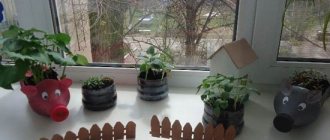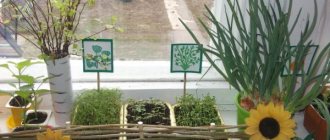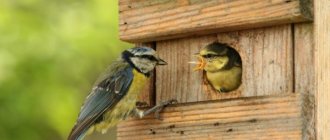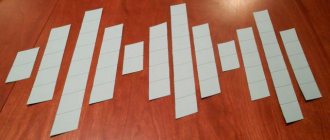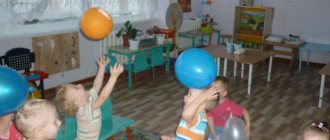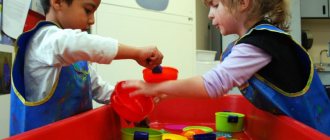Lesson on cognitive and research activities in the second junior group of kindergarten
Children 3–4 years old have an inquisitive mind; they can be interested in any subject in any situation, spontaneously. It is important for the teacher to notice such moments during the children’s independent activities in order to include them in joint research work. Elements of experimentation with younger preschoolers are used during classes on the surrounding world (“Orange, its features,” “What is snow”), during creative classes (“Mixing colors,” “Learning to sculpt from clay”), musical (“How do they sound?” metal, clay, porcelain bells"), etc. Observations on walks occupy a special place.
In the process of carrying out research activities, the teacher helps younger preschoolers at every stage of work. Speech accompaniment of all actions during experimentation is required (in the senior and preparatory groups, children will begin to pronounce their actions while the teacher does it for them). The teacher uses the direct demonstration method for the entire group and, if necessary, additionally for those children who have difficulties in performing the experiment.
During the experimentation process, the teacher talks through everything that is happening.
Children should not perceive research activities as specific work. The teacher does not prepare them for the profession of a scientist in the future, but teaches them exciting and effective ways to understand the world around them.
When constructing the practical part, the teacher takes into account the age characteristics of younger preschoolers. One research procedure can be divided into several separate stages. The learning process can be interrupted to prevent fatigue (playing and sports exercises, a musical break).
Table: forms of organizing research activities with children 3–4 years old
| Criteria for organizing research | Research forms |
| By the nature of the research objects |
|
| At the location of the experiment |
|
| Due to research |
|
| By the number of children participating in the experiment |
|
| By duration |
|
| By the nature of cognitive activity |
|
| By place in the cycle of educational activities |
|
| By the degree of inclusion in the educational process |
|
| By the nature of mental operations |
|
Card file of topics on research activities in the second junior group
| Research topic | Research objectives |
| "Sand and its properties" | Formation of ideas about sand, its properties in various states (dry and wet). |
| "What is the wind" | Learning the skills to study intangible objects using special instruments (to study the properties of wind you will need pinwheels, flags, nets, and a weather vane). |
| "Sun" | Expanding knowledge about the sun, the properties of its light and heat. |
| "Bubble" | Expanding knowledge about the properties of air. |
| "Stones" |
|
| "Fruits" | Learning to characterize the object of study in different aspects (lemon: by color - yellow, by smell - pleasant, aromatic, by taste - sour, by tactile sensation - smooth with small pimples, etc.). |
| "We are explorers" |
|
| "Snow and Ice" | Introducing children to the solid state of water, its characteristics, and the conditions for returning to the liquid state. |
| "Water and its properties" |
|
| "What smells?" | Developing children's sensory experience through smell. |
| "Roll, balls" |
|
| "Clay" |
|
| "Shadow" | Expanding knowledge about the ability of objects to cast shadows. |
| "The soil" | Formation of ideas about the soil (what it consists of) and its properties (it heats up, absorbs water, serves as a nutrient medium for plant growth). |
| "Paper boat" | Expanding knowledge about the properties of paper. |
| “Why do the buds bloom?” |
|
| "Chalk and Coal" | Formation of the ability to compare materials by properties and qualities. |
| "Drowning - not drowning" | Acquaintance with the ability of water to push objects made of rubber, plastic, wood, and foam. |
Motivating start to classes
Classes on cognitive activities with pupils of the younger group should be bright. A high level of curiosity and emotionality allows a preschooler to fill his long-term memory with images that impress him. How interested and involved the child is in the educational process at the beginning of the lesson depends on his activity during direct research activities, the result of solving the problem posed and the degree of motivation for experimentation in the future. The teacher needs to use a variety of forms for conducting the initial stage of the lesson, which will add variety to the usual activities of preschoolers.
Demonstration of the research object will help to arouse children’s interest at the beginning of the lesson.
Table: examples of a motivating start to a lesson
| Cognitive Research Topic | Option for a motivating start to the lesson |
| Forming children’s ideas about the properties of ice (lesson “Releasing beads from ice”) | Creating a surprise moment with a problematic situation. A Dymkovo toy comes to the group (in the role of a Dymkovo young lady - a pupil of the preparatory group, a senior teacher or another employee of the preschool educational institution by agreement), she is upset and complains to the children. The toy was invited to visit by a young lady she knew; she was in a hurry to have a friendly tea party and caught her beads on a branch in the winter forest. The thread broke and the beads scattered. The toy has collected them, but cannot string them on a thread because the beads are covered with ice (shows the children ice cubes with beads in the middle brought in a bowl). The guys will have to find a way to remove the beads so that the Dymkovo young lady can repair the jewelry and have time for a visit. |
| Introducing children to the properties of sand (lesson “Secrets of Sand”) | Game motivation. A fairy-tale guest is waiting in the group of children (it could be Aladdin, Dunno, etc.), he reports that he has arrived from the land of sands. The guest talks with the children (do they know what sand is, where they saw it, how they played with it), shows photographs of a wonderful country. He reports that he is ready to teach the children new games with sand, which the inhabitants of the land of sands love so much. |
| Formation in children of elementary ideas about how soap bubbles are made (lesson “How to make soap bubbles?”, preparation for the event “Bubble Festival”) |
|
| Cognitive development of children, working with flour and dough (integrated lesson “Wonderful Flour”) | Creating a game situation based on the previously studied fairy tale “Masha and the Bear”. At the beginning of the lesson, the teacher informs the children that near the garden she met a bear from a fairy tale: Everyone sit down in a row, Let's play nicely! Get your ears and eyes ready, let's begin our fairy tale. Today I came to the garden and found a roar bear. Mishka cried near the garden: “I want to go to kindergarten, to the kids!” Then the teacher asks what is the reason for the bear’s sadness (a plush toy can be used as a bear, or it is possible for a student in the senior group to play the role of a bear). Mishka says that Mashenka sent him to take the pies to his grandfather and grandmother, and he ate them on the way and is now sad that he violated the girl’s ban on not sitting on a tree stump and not eating the pie. The guys will help the bear by studying the characteristics of flour and methods of preparing and modeling dough (in class - from salt dough). |
Table: fragment of the lesson notes “Introducing children to search-cognitive activities” in the second junior group (using the example of the topic “Water”)
| Author | Telgina O., teacher at Moscow Children's Educational Institution No. 24, Novotroitsk, Orenburg region. |
| Lesson objectives |
|
| Equipment |
|
| Progress of the lesson | V.: Guys, look how many guests we have, let's say hello to them. Now look at me everyone. We will play with you. One, two, three, everyone look at me! (Teacher dressed as Moidodyr). Guys, you recognized me. Who am I? (Children's answers).
Guess my riddle and play with the answer.
The teacher invites the children to get to know the water better. The guys study what sounds water makes, what color, smell, and taste it is. <…> V.: And now our magic continues. Let's add some paint to our cups and then see what we get. (Carry out an experiment). What kind of water has it become? Is anything visible through it? (Children's answers). Well done boys! Now let's play. Physical exercise “Drops”.
Q: Guys, do you know why we need water? (Wash, bathe, cook, do laundry, etc.). Well done, guys. Who needs water? (Fish, birds, animals, plants). Oh, guys, look what kind of bottles we have. Yes, they are with water! Let's go and see why they are standing aside? How many are there? (A lot of). Are they the same? (Yes, they are all small, the same color). How are they different? Let’s touch them with our hands. (Children touch bottles with cold, hot and warm water in turn). How are these bottles different? (Children's answers). How did you know what kind of water was in the bottles? (Touched with hands). Why do we need hot water? (Drink tea, eat soup, wash dishes, swim). Guys, why do you think we need warm water? (Wash, wash clothes, brush your teeth, etc.). Why do we need cold water? (Drink water, rinse clothes). Do you know what happens to water if you put it in the cold? Let's pour water into the molds and ask Svetlana Vladimirovna to take it out into the cold and see what happens. Are you interested in playing with me? (Children's answers). Questions for reflection:
V.: Look, guys, Svetlana Vladimirovna brought us our molds. What happened to the water? (Children's answers). Yes, that's right, the water froze. Water is not only liquid, but also solid. What a magic water! Well done kids, you did a great job today! Now one, two, three, everyone look at me. Now let's say goodbye to the guests and go for a walk and play. |
| Quote from: https://www.maam.ru/detskijsad/konspekt-zanjatija-na-temu-oznakomlenie-detei-s-poiskovoi-poznavatelnoi-dejatelnostyu-po-teme-voda-vtoraja-mladshaja-515502.html | |
Temporary lesson plan for the younger group
The duration of an educational lesson in the second junior group, according to SanPiN standards, is 15 minutes. The lesson should have a clear structure, including various types of activities. Since cognitive and research activities require mental effort, such classes should be conducted in the first half of the day, preferably on Tuesday or Wednesday - days of high performance. In the afternoon, it is possible to organize a circle for experimental activities and conduct short-term observations on evening walks.
To avoid overtiring of children, educational and research activities are conducted in the first half of the day.
Approximate time plan for a lesson on cognitive and research activities in the second junior group:
- Organizational moment - 1 minute.
- Motivating start of the lesson - 3 minutes.
- Constructing a research plan, talking through the stages of the experiment with the guys - 2 minutes.
- Physical activity (exercises, finger exercises, outdoor play) - 2 minutes.
- The practical part of the work is 6 minutes.
- Formulation of research results, summing up – 1 minute.
Table: examples of temporary lesson plans
| Lesson topic | Organizing time | Motivating start to class | Constructing and speaking a research plan | Physical activity | Practical work | Summarizing |
| “Why does the icicle cry in the spring?” | 1 minute. | Creating a problematic situation. The group receives a letter from the Snow Queen, in which she reports that the icicles on the roof of her palace have begun to melt. She asks the guys to find out the reason for the melting. 3 minutes. | 2 minutes. | Outdoor game "Snowflakes". 2 minutes. | Conducting an experiment to observe the melting of ice. 6 minutes. | 1 minute. |
| "Clay and its properties" | 1 minute. | Conducting a conversation on the topic “Clay toys” with viewing the exhibition. 2–3 minutes. | 1–2 minutes. | Finger gymnastics “I play with toys.” 2 minutes. | Conducting research on clay material. 6 minutes. | 1 minute. |
| "Drowning - not drowning" | 1 minute. |
3 minutes. | 1 minute. | Physical education 2 minutes. | Conducting an experiment with a ball and water. 6 minutes. | 1 minute. |
Organization of research work with children of the second junior group
Olga Komarova
Organization of research work with children of the second junior group
Municipal budgetary preschool educational institution: combined kindergarten No. 5 “Squirrel”
Asino, Tomsk region
«Organization of research work with preschoolers»
WITH CHILDREN OF THE SECOND YOUNGER GROUP
Prepared and conducted:
teacher Komarova O.V.
-2015-
In the Federal Law “On Education”
it is indicated that every child grows up not only as a conscious member of society, not only as a healthy and strong person, but also as an initiative, thinking person, capable of a creative approach to any matter.
Considering the trend of modernization of preschool education, the priority direction in the activities of preschool educational institutions is the activation of cognitive interests and the formation of research in preschool children.
Every preschooler is a little explorer and discoverer , discovering the world around him with joy and surprise. Research activities are of great interest to children. Research provides the child with the opportunity to find answers to the questions “how?”
and
why?"
.
Research activity is the natural state of a child, he is determined to understand the world, he wants to know everything, explore , discover, study - it means taking a step into the unknown.
This is a huge opportunity for children to think, try, experiment, and most importantly, express themselves. N. N. Poddyakov identifies experimentation as the main type of research (search)
activities. “The more varied and intense the search activity, the more new information the child receives, the faster and more fully he develops...”
During research activities, the preschooler learns to observe, reflect, compare, answer questions, draw conclusions, establish a cause-and-effect relationship, and follow safety rules. It is important not to let this desire fade: the richer and more varied the activity, the more significant it is for the child; The more prepared he is to carry out the study and research of the natural world , the more successfully his abilities develop and are realized.
It is important to remember that the most valuable and lasting knowledge is not that which is acquired by memorization, but that which is acquired independently, in the course of one’s own creative research. A Chinese proverb says: “Tell me and I will forget, show me and I will remember, give try and I’ll understand.” The most important thing is that it is much easier for a child to learn science by acting like a scientist, conducting research and conducting experiments, than by receiving knowledge obtained by someone else in a ready-made form. Everything is learned firmly and for a long time when the child hears, sees and does it himself.
The skills and abilities of a researcher acquired in children's games and special classes are easily instilled and transferred to all types of activities. Therefore, our task is to create full-fledged conditions for the development of research competence in preschoolers, for independent experimentation and search activity of children.
The goal of my work is to develop cognitive activity, curiosity, and the desire for independent knowledge of the world around us and reflection in preschool children.
I outlined the tasks:
1. Expand children’s understanding of phenomena and objects of living and inanimate nature, through experimental activities, to identify some properties of objects;
2. Develop children’s cognitive interest, logic, imagination, thinking, observation, ability to draw conclusions, establish cause-and-effect relationships;
3. Cultivate curiosity, a careful, caring attitude towards nature, accumulate emotional and sensory experience in the process of direct communication with nature;
4. Form a conscious, correct attitude towards human activity.
Elementary research activity is understood as the joint activity of an adult and a child, aimed at solving cognitive problems that arise in the process of educational activities, in everyday life, play, work, i.e. in the process of learning about the world.
Main features of children's research activities :
1. it is aimed at obtaining new knowledge about the natural world;
2. contributes to the formation of a system of knowledge about nature;
3. develops cognitive activity;
4. promotes the development of thought processes and operations;
5. influences the development of the child
While studying the latest in methodological literature and observing children , I drew attention to a wonderful means of intellectual development for preschoolers - children's experimentation. The process of cognition is a creative process, and our task is to support and develop in the child an interest in research and discovery, and to create the necessary conditions for this.
In early preschool age I use the following methods:
1. Method of children's experimentation (formation of initial prerequisites for search activity)
2. Method of modeling problem situations (entry of children into a problem game situation by a teacher)
;
3. Project method (activating the desire to look for ways to resolve a problem situation together with parents and teachers);
In early preschool age, research activities are aimed at objects of living and inanimate nature through the use of experimental games and experiments. I include experimentation in various forms of work with children : excursions, walks, work activities, observations, conducting experiments organized as independent or joint activities.
One of the main conditions for the successful organization of research activities is the creation of a subject-development environment:
1. Experimentation zone (to show the child’s initiative and independent research ).
2. Water and sand center (designed for experimenting with water and sand)
.
3. Natural corner (for growing and caring for indoor plants)
.
4. Vegetable garden on the windowsill (created to monitor the growth of plants)
.
The group has created an experimentation corner. Children work in the corner not only in the process of specially organized activities , but also practice individual research practice . My task is to help the child organize his experimental research activities .
Children use the center of water and sand to study the properties of sand, water, air, and the composition of the soil. In the center of water and sand, children play: pour sand from palm to palm, from a scoop to a mold, bury various objects in it and dig them out, build slides, paths. They conduct experiments: pour, filter through a sieve, pour through watering cans, through straws, splash in the water, revealing its secrets; ships are sent sailing. Do they see and understand which objects do not sink in water and why? Examining sand through a magnifying glass, they discover that it consists of small crystals-grains of sand, this explains the property of dry sand - flowability, they discuss which sand can be used to sculpt and build, and which cannot.
Interaction with plants helps children understand their relationship to the world around them, develops observation, attention, and thinking.
In a corner of nature, children receive their first skills in caring for plants, and I demonstrate to them by personal example the correct attitude towards natural objects. I invite children to say hello to the plants themselves and say kind words to them. I definitely praise them for taking care of indoor plants and tell parents how well and skillfully they help adults.
Every year a “Winter Garden on the Window” with my children.
.
The process of planting onions, dill, and parsley is of great interest to children. Children learn to work , look after and observe the results of their work. I talk about the benefits of grown plants. I try to bring the children’s understanding to the fact that without water, light and heat the plant will not survive.
When working with children, I use those forms of activity that bring joy to the child and harmoniously develop him. They experience great joy, surprise and even delight from their small and large discoveries, which give children a feeling of satisfaction from the work . Children enjoy activities where, together with adults, they make their first discoveries, learn to explain and prove. Thanks to experiments, children compare, contrast, draw conclusions, express their judgments and conclusions...
the content of the training in the form of a game ( “What different pieces of ice”
,
“Multi-colored water”
,
“Journey of a droplet”
,
“Where did the snowman go”
, since this is the leading activity.
In the process of working , playing with children , I try to create problem situations that allow the child to draw some independent conclusions. With the help of the game character - Dunno, I offer children the simplest problem situations: “Why do we need water?”
,
“What will float and what will sink?”
, “What happens if you don’t water the flowers?
Developing the plot of the role-playing game “Gift for a Kitten”
, I propose to make a cake from dry sand. Nothing works out and the children reason why. The emerging problem situation activates the cognitive activity of children. Children come to the conclusion that the sand must be wet.
Using the game situation “Let’s treat the little fox with pies”
learned that you can sculpt from clay.
The youngest preschooler is characterized by an increased interest in everything that happens around him. Every day my students learn more and more new objects, strive to learn not only their names, but also their similarities, and think about the simplest reasons for the observed phenomena. For children of the 2nd junior group, experiments and observations are repeated , complicated, and transferred from the group to the natural environment .
In my work , I try to use new technologies to maintain interest in knowledge, children’s desire to explore the world, learn, use acquired knowledge, and solve emerging problems. And all this can be implemented in project activities. Project activities help create conditions for children their abilities and personal potential.
The project method is one of the new types of activities that today we actively use in the educational process, which allows children to carry out their first experiments in independent research work . Projects have been carried out: “Wintering birds”
,
“Wild animals of our forests”
,
“Is snow beneficial or harmful”
,
“Vitamins on the window”
.
Experiments with snow helped to find out how dirty it is, although white seems clean, they made it clear to the children that snow should not be eaten, it is harmful to health.
Project “Vitamins on the Window”
Helped children gain a better understanding of plant life.
He expanded children's understanding of plants as living organisms , the conditions necessary for the growth and development of plants, the ability to enjoy the beauty of the plants grown and the results of their work.
A child’s life position is established in the family. To develop children’s cognitive activity and maintain interest in experimental activities, I involve parents in partner activities, since it is through activity that a person influences the world around him. Children are happy to tell their parents about their discoveries, perform the same experiments at home, learn to put forward new problems and solve them independently. I try to promote children’s experimentation: I conduct educational work with parents , create photo reports about children’s research activities , and hold exhibitions “What a Miracle” vegetables"
,
“Crafts from natural materials”
, environmental campaigns
“Let’s turn garbage into toys”
(crafts from waste materials,
“Help birds survive” (making feeders, providing food)
. Parents provide assistance in collecting collections, exhibits from natural materials, growing plants for corner of nature.
Analyzing all of the above, we can conclude that organized research activities allow the teacher to make the learning process effective and more fully satisfy the natural curiosity of preschoolers, developing their cognitive activity.
In conclusion, I would like to quote the words of K. E. Timiryazev: “People who have learned to observe and experiment acquire the ability to pose questions themselves and receive factual answers to them at a higher mental and moral level in comparison with those who have not gone through such a school.”
Used Books:
1. Magazine “Preschool education No. 6, 2007.”
2. Tugusheva G. P. Chistyakova A. E. “Experimental activities of children of middle and senior preschool age, 2007.
3. “ Organization of experimental activities of preschool children”: Methodological recommendations, ed. Prokhorova L.N. – M.: “Arkti”
4. Magazine "Preschooler"
№4, 2010
5. "Environmental work in preschool educational institutions "
V. N. Chernyakova, creative
2008
Research project in the second junior group of a preschool educational institution
The term “research activity” in pedagogy refers to a form of child activity aimed at studying an object or group of objects in order to search for meaningful information. As mentioned earlier, elements of research activity are present in ECD classes, in creative and sports exercises, in the structure of games and walks. The desire to experiment and search for knowledge through experience is inherent in human nature; the teacher’s task is to improve children’s research abilities and develop thought processes.
A research project is one of the forms of organizing the cognitive activity of a child or group of children. The project aims to study a problem for which the solution is unknown in advance. This form of work has a number of strict requirements (from formulating a current and new research goal to putting forward a hypothesis and determining study methods); observations must be recorded in order to ultimately present the completed project for defense.
Individual project activities are carried out with older preschoolers who have sufficiently developed the ability to compare, systematize, analyze, generalize and determine cause-and-effect relationships. It is possible to implement collective projects with children aged 3–4 years. As part of the work on the theme of the project, various types of classes, recreational activities, and parent-child events are held.
Depending on the duration of the work, the project can be short-term or long-term. Projects whose goal is to observe the process of change and transformation of an object (growing plants, observing the course of the sun, the annual natural cycle) are of great length. It is recommended to carry out short-term projects to coincide with significant dates (Autumn Festival, Cosmonautics Day, Ecology Week, events to help wintering birds).
For example, as part of the short-term project “Miracles, Tricks, Experiments”, pupils of the younger group can watch sunbeams, get acquainted with the properties of air, sand, water, soap, etc.
Photo gallery: research project “Where did the bread come from” in the second junior group
At the first stage of the research project, a lesson “How bread is made” is held.
As part of the project, an exhibition of drawings “From a grain to a loaf of bread” is being organized.
Watching thematic cartoons contributes to the formation of environmental awareness in preschoolers
By participating in the process of kneading dough and baking bread, children acquire useful skills
The group's students made this bread
During leisure time, an exhibition and tasting of types of bread from the world's peoples is held
The guys participate in listening and discussing fairy tales and stories about bread
At the end of the project, a photo book is created about the work done
A child of primary preschool age is open to learning about the world around him; he is a born researcher. Let him be inspired by the joy of acquiring new knowledge and strive to find hidden information. A little researcher should not be afraid of mistakes; he tries to find answers to the questions that arise on his own and takes active action. A high level of development of research skills is the key to successful training and mastering a profession in the future.
